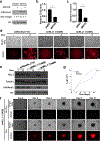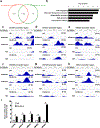Bcl-xL is translocated to the nucleus via CtBP2 to epigenetically promote metastasis
- PMID: 39265800
- PMCID: PMC11471366
- DOI: 10.1016/j.canlet.2024.217240
Bcl-xL is translocated to the nucleus via CtBP2 to epigenetically promote metastasis
Abstract
Nuclear Bcl-xL is found to promote cancer metastasis independently of its mitochondria-based anti-apoptotic activity. How Bcl-xL is translocated into the nucleus and how nuclear Bcl-xL regulates histone H3 trimethyl Lys4 (H3K4me3) modification have yet to be understood. Here, we report that C-terminal Binding Protein 2 (CtBP2) binds to Bcl-xL via its N-terminus and translocates Bcl-xL into the nucleus. Knockdown of CtBP2 by shRNA decreases the nuclear portion of Bcl-xL and reverses Bcl-xL-induced invasion and metastasis in mouse models. Furthermore, knockout of CtBP2 not only reduces the nuclear portion of Bcl-xL but also suppresses Bcl-xL transcription. The binding between Bcl-xL and CtBP2 is required for their interaction with MLL1, a histone H3K4 methyltransferase. Pharmacologic inhibition of the MLL1 enzymatic activity reverses Bcl-xL-induced H3K4me3 and TGFβ mRNA upregulation, as well as invasion. Moreover, the cleavage under targets and release using nuclease (CUT&RUN) assay coupled with next-generation sequencing reveals that H3K4me3 modifications are particularly enriched in the promotor regions of genes encoding TGFβ and its signaling pathway members in cancer cells overexpressing Bcl-xL. Altogether, the metastatic function of Bcl-xL is mediated by its interaction with CtBP2 and MLL1 and this study offers new therapeutic strategies to treat Bcl-xL-overexpressing cancer.
Keywords: Bcl-xL; CtBP2; Epigenetic modification; H3K4me3; Metastasis.
Copyright © 2024 Elsevier B.V. All rights reserved.
Conflict of interest statement
Declaration of competing interest The authors declare no competing financial interests.
Figures








Update of
-
Bcl-xL is translocated to the nucleus via CtBP2 to epigenetically promote metastasis.bioRxiv [Preprint]. 2023 Apr 28:2023.04.26.538373. doi: 10.1101/2023.04.26.538373. bioRxiv. 2023. Update in: Cancer Lett. 2024 Nov 1;604:217240. doi: 10.1016/j.canlet.2024.217240. PMID: 37163116 Free PMC article. Updated. Preprint.
References
-
- Boise LH, Gonzalez-Garcia M, Postema CE, Ding L, Lindsten T, Turka LA, Mao X, Nunez G, Thompson CB, bcl-x, a bcl-2-related gene that functions as a dominant regulator of apoptotic cell death, Cell, 74 (1993) 597–608. - PubMed
-
- Fernandez Y, Espana L, Manas S, Fabra A, Sierra A, Bcl-xL promotes metastasis of breast cancer cells by induction of cytokines resistance, Cell Death Differ, 7 (2000) 350–359. - PubMed
MeSH terms
Substances
Grants and funding
LinkOut - more resources
Full Text Sources
Research Materials

